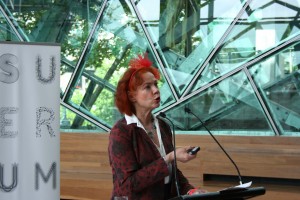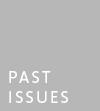I have just spent two days at ANAT’s Super Human symposium in Melbourne. With a focus on the human body in the context of interactions between art and science, it was presented with partner events – exhibition and masterclass – and alongside associated events including Re:live.

Barbara Maria Stafford (USA), presenting 'Slow Looking' Keynote at the Super Human symposium. Photographer Adinda van't Klooster.
Super Human’s strong international representation began with the first keynote speaker, Barbara Maria Stafford (US), whose mission is to build bridges between the humanities, especially visual culture and neuro- and cognitive science. Her talk was wide-ranging and featured the idea of “slow looking”, or paying mindful attention to something outside of oneself. Automatic mechanisms of perception and the like have been much studied, but deliberately focused attention apparently has not.
Other key themes included prostheses, extensions of the body (in various senses) and devices to assist people with disabilities. Another keynote speaker, Ju Gosling (UK), a passionate campaigner for the rights of disabled people (she uses a wheelchair herself), would argue at least in part that the normal/impaired dichotomy is to be avoided; we all have our problems. It seemed she supported medical intervention but argued that in general technical substitutes for body parts are inferior – using hip joints as an example (the artificial lenses I have in my eyes after cataract operations may be an exception, as I am much less short-sighted than I was before the operations). Ju was strongly opposed to the idea that medical science will soon solve all of our problems, so we don’t have to worry about the disabled, as soon they will be “fixed”.

Ju Gosling (UK) presents her "Super Human Rights" Keynote at the symposium. Photographer Adinda van't Klooster.
Next we heard a rather wide-eyed and visionary talk from Natasha Vita-More (USA), who believes that the combination of “nano-bio-info-cogno-neuro” will solve all our problems and improve on our natural bodies. In particular she likes the idea of extended life spans.
Junichi Ushiba (Japan) is a scientist who has been working with a practical brain-machine interface device, which allows a quadriplegic with minimal limb movement to control an avatar in Second Life purely by thought alone (imagining movement). It provides very real potential for stroke victims to regain some function. This work is tied up with the body image of the participants, which is often damaged after the stroke.
All of these concepts were related to an emergent theme of “embodied consciousness” and the role of emotions. How important is feeling and moving to thinking? The consensus appeared to be that our sensory-motor systems are indeed very important to brain function.
There were two talks on scientific visualisation. Dolores Steinman (Canada) talked about the different representations of the same data (in this case on blood flow) required by physicists, engineers and medical practitioners; the varied requirements due to training and disciplinary culture as much as anything else. Tami Spector (USA), an organic chemist, spoke about “nanoaesthetics”, the visualisation of atomic-scale structures through conventional chemical structure diagrams and through images obtained by techniques like atomic force microscopy. These images are derived in an indirect fashion and are not comparable with photographs, but we tend to accept them as such. There is a very good question as to what they actually represent.
Svenja Kratz, a student at QUT in Brisbane, discussed her artistic work involving human cells and the ethical issues that arose. Svenja was able to purchase and use (even to feed them to ants) cancer cells derived originally from an anonymous 11-year-old girl, without ethics clearance. But to obtain cells from volunteers (who were keen to be involved), an elaborate ethics clearance process was needed. Svenja commented that, as a result, her own views on ethical matters have changed considerably and she was inspired to fashion art works to create an imagined identity for the anonymous girl.

Svenja Kratz (AUS), presenting her paper. Photographer Adinda van't Klooster.
Kathryn Hoffmann (USA) talked about some extraordinary displays that were once seen in anatomy museums – artworks made from bones and body parts. There is a link here to the nineteenth century practice of mortuary photography (including children) taken and used as mementos. The anatomy collections discussed are now largely inaccessible and in storage; however Kathryn is campaigning for some to be re-opened. The public treatment of death oscillates over time, and Kathryn thought a public focus on death was coming back. The question of respect for the dead was raised, to which Kathryn replied that she thought the present treatment of these images stuck in boxes in a warehouse was more disrespectful than any public display would be.
There was much more, many of the topics introduced by artists discussing their practices, including the phenomenology of avatars and virtual bodies, using software that can read faces to detect emotions, a project from Sydney University to make a figure with artificial touch-sensitive skin (how should a robot react to being touched?), the design of medicinal jewellery (devices that serve medical purposes as well as looking attractive), and so on.

Paul Brown concludes the symposium
The final talk was by Paul Brown (UK/Australia), who had the task of summing up the conference. He outlined three possibilities for engagement of art and science. In the first, an artist appropriates scientific ideas for artistic ends, often treating the science in a critical or hostile manner. Conversely a scientific group may use artists as designers to make their own scientific work look good, essentially for PR purposes. The third and most desirable engagement is a true collaboration, where artists are involved early in the project, both sides equally contributing and benefiting. We heard about several such successful collaborations during the conference.
Most of the speakers were women, an outcome apparently not planned by the organisers. I did hear a rather acid comment (from a woman) that women were playing out their traditional role of handmaidens to, in this case (male) scientists. I don’t think this was fair, as in many cases it seemed that the artists in such collaborations were taking the lead or were equal partners. Also among the six or so (self-identified) scientists and engineers who spoke, two were women, and at least some of the (self-identified) artists had a high degree of technical knowledge. Plus a substantial proportion of biologists (in particular) are female. The male scientist/female artist divide may still exist, but the lines are getting rather blurred. My take on this is simply that there are a lot of successful female artists.
A positive outcome of the conference – it appears that Australia is a pretty good place for art-science engagement.
Gordon Monro
Gordon Monro is a digital media artist based in Ballarat, Victoria; his current work uses simulated evolutionary processes. Gordon is undertaking a PhD in computer-based art at Monash University.
Read More
http://www.mediaarthistory.org/relive/index.html
See More
http://www.flickr.com/photos/anat_flickr/sets/72157622964520282/
 This work is licensed under a Creative Commons Attribution-NonCommercial-ShareAlike 2.5 Australia.
This work is licensed under a Creative Commons Attribution-NonCommercial-ShareAlike 2.5 Australia.







[...] ANAT’s Super Human: Revolution of the Species reflected some of these concepts – http://www.superhuman.org.auYou can read reviews of Super Human here – https://filter.anat.org.au/issue-73/review-super-human-revolution-of-the-species/ [...]